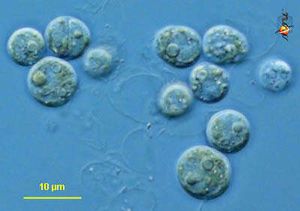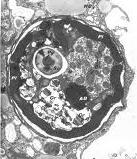Symbiodinium Symbiosis: Difference between revisions
Nicolehebert (talk | contribs) |
Nicolehebert (talk | contribs) |
||
| Line 1: | Line 1: | ||
==Characteristics of the Symbiont: ''Symbiodinium sp.''== | ==Characteristics of the Symbiont: ''Symbiodinium sp.''== | ||
<u>Phylogeny</u>: Domain Eukaryota, Kingdom Chromalveolata, Phylum Dinoflagellata, Class Dinophyceae, Order Suessiales, Family Blastodiniaceae, Genus Symbiodinium | [[File:symbiodinium.jpeg|thumb|''Symbiodinium sp.'']] | ||
<u>Phylogeny</u>: Domain Eukaryota, Kingdom Chromalveolata, Phylum Dinoflagellata, Class Dinophyceae, Order Suessiales, Family Blastodiniaceae, Genus Symbiodinium | |||
Symbiodinium is a genus of diverse endosymbiotic algae with genus members commonly referred to as zooxanthellae (Blank 1987, van Oppen et al. 2001, and Weis et al. 2001). Being algae, organisms of symbiodinium are autotrophic and eukaryotic, gaining energy from photosynthesis (Blank 1987). Individual cells are coccoid and at times produce flagella to enhance motility (Blank 1987). | Symbiodinium is a genus of diverse endosymbiotic algae with genus members commonly referred to as zooxanthellae (Blank 1987, van Oppen et al. 2001, and Weis et al. 2001). Being algae, organisms of symbiodinium are autotrophic and eukaryotic, gaining energy from photosynthesis (Blank 1987). Individual cells are coccoid and at times produce flagella to enhance motility (Blank 1987). | ||
Revision as of 21:57, 29 November 2011
Characteristics of the Symbiont: Symbiodinium sp.
Phylogeny: Domain Eukaryota, Kingdom Chromalveolata, Phylum Dinoflagellata, Class Dinophyceae, Order Suessiales, Family Blastodiniaceae, Genus Symbiodinium
Symbiodinium is a genus of diverse endosymbiotic algae with genus members commonly referred to as zooxanthellae (Blank 1987, van Oppen et al. 2001, and Weis et al. 2001). Being algae, organisms of symbiodinium are autotrophic and eukaryotic, gaining energy from photosynthesis (Blank 1987). Individual cells are coccoid and at times produce flagella to enhance motility (Blank 1987).
Characteristics of the Host: Coral
Phylogeny: Domain Eukaryota, Kingdom Animalia, Phylum Cnidaria, Class Anthozoa
Many coral species form obligate endosymbiotic relationships with dinoflagellates, or eukaryotic organisms with flagella (van Oppen et al. 2001). For example, the Hawaiian stony coral (Montipora verrucosa), corals of the genus Acropora, and Fungia scutaria all rely on zooxanthellae for survival (Blank 1987, van Oppen et al. 2001, and Weis et al 2001).
Host-Symbiont Interaction
Zooxanthellae are found in gastrodermal cell vacuoles of the coral they reside in (Weis et al. 2001).
Gastrodermal cells are cells that line the gastrovascular cavity, where nutrients are digested and distributed (Wikipedia). Coral are born azooxanthellate, symbiont free, and are infected with the symbiont horizontally while in the polyp stage through either feeding or phagocytosis by gastrodermal cells (Weis et al. 2001). Zooxanthellae provide photosynthetically fixed nitrogen to coral while coral provides inorganic nutrients, a high light environment, and protection from the threat of aquatic herbivores (Weis et al. 2001). Without zooxanthellae coral experience severely reduced growth, survivorship, and fitness (Weis et al. 2001). Coral form highly specific relationships with zooxanthellae, only taking in one zooxanthellae species per colony. The most successful coral-zooxanthellae relationships occur with homologous strains (Weis et al. 2001). Coral infected with zooxanthellae only found in other coral species either form a weak symbiotic relationship or lose the symbiont altogether (Weis et al. 2001).
Molecular Insights into the Symbiosis
Describe molecular/genetic studies on the symbiosis.
Ecological and Evolutionary Aspects
What is the evolutionary history of the interaction? Do particular environmental factors play a role in regulating the symbiosis?
Recent Discoveries
Describe two findings on the symbiosis published within the last two years.
References
[Sample reference] [[1] Seemanapalli SV, Xu Q, McShan K, Liang FT. 2010. Outer surface protein C is a dissemination-facilitating factor of Borrelia burgdorferi during mammalian infection. PLoS One 5:e15830.]
Edited by [insert your names here!], students of Grace Lim-Fong
This template is just a general guideline of how to design your site. You are not restricted to this format, so feel free to make changes to the headings and subheadings and to add or remove sections as appropriate.


